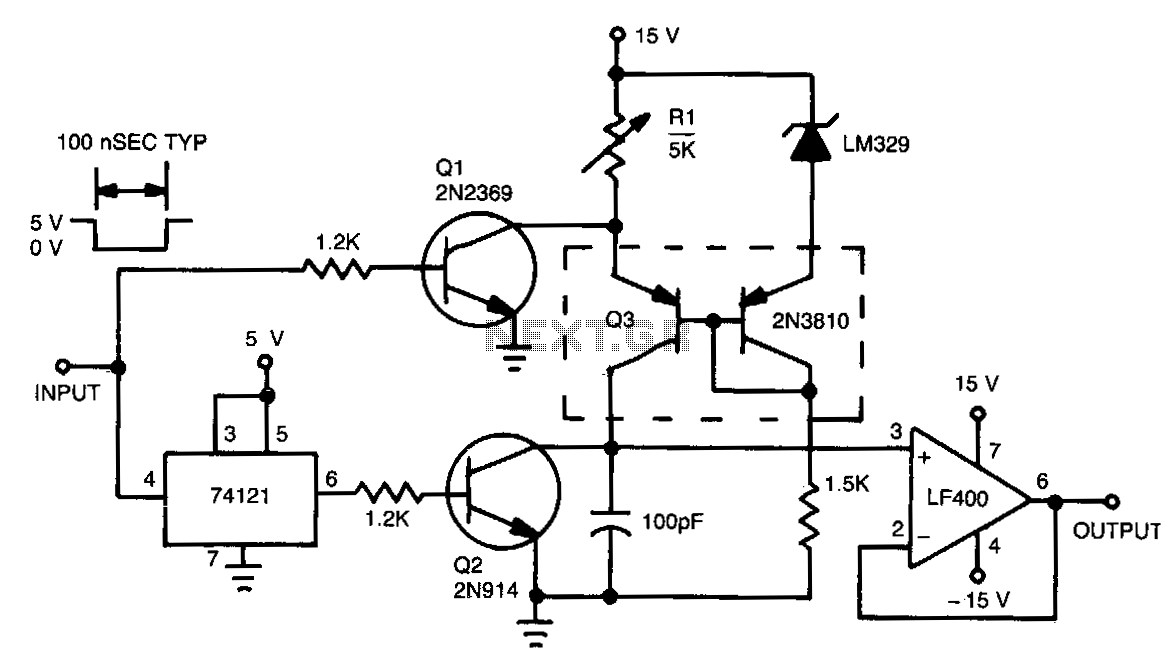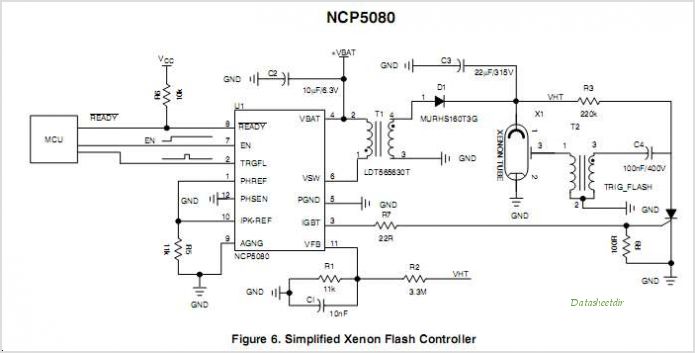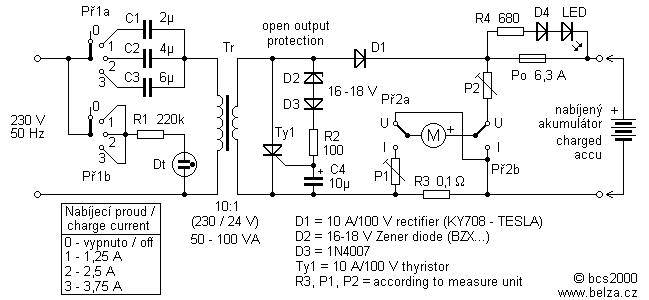
Capacitor Esr Measurer

The equivalent series resistance (ESR) of a capacitor can be measured using this circuit and an AC voltmeter. It functions as a 50-kHz square-wave generator, driving a current waveform of approximately ±180 mA through the capacitor-under-test via resistors R1 and R2. When resistor R3 is adjusted to the appropriate value, the voltage drop across the equivalent series resistor is nullified by the inverting amplifier (U2). Consequently, V0 represents the pure capacitor voltage, which is the minimum voltage that can be produced at V0. To measure the AC voltage, adjust R3 until V0 is minimized. The position of the potentiometer is then noted and multiplied by the value of R2, which is set to 1 in this case. The resulting product equals the capacitor's ESR. The capacitor is biased at approximately 7.5 V, and lower-voltage capacitors are incompatible with this circuit. By altering the value of R2, different ESR ranges can be measured. However, for smaller R2 values, the current level should be increased to maintain a reasonable voltage across R2, necessitating the use of a buffer. The circuit is designed for capacitors greater than 100 µF, as the ripple voltage increases for smaller values, leading to decreased accuracy.
The circuit for measuring the equivalent series resistance (ESR) of a capacitor is a specialized design that utilizes a combination of resistors, an inverting operational amplifier, and a square-wave generator. The square-wave generator operates at a frequency of 50 kHz, providing a stable AC signal to the capacitor-under-test. The current waveform produced is approximately ±180 mA, which is sufficient to create a measurable voltage drop across the equivalent series resistance of the capacitor.
Resistors R1 and R2 are crucial components in this circuit, as they help establish the current path and influence the voltage drop across the capacitor. R3 acts as a variable resistor or potentiometer, allowing for fine adjustments to be made until the voltage drop across the equivalent series resistor is nullified. This nulling process is essential for obtaining an accurate reading of the capacitor's voltage, V0, which represents the pure voltage across the capacitor without the influence of the ESR.
The output voltage V0 is minimized by adjusting R3, and the position of the potentiometer is recorded. The value of R2, typically set to 1 ohm, is then multiplied by the noted position of R3 to calculate the ESR of the capacitor. This method ensures that the measurement is accurate and accounts for any variations in the circuit.
The circuit is designed to operate with capacitors biased at approximately 7.5 V. It is important to note that this circuit is not suitable for lower-voltage capacitors, as they may not function correctly under these conditions. Additionally, the design allows for the adjustment of R2 to measure different ESR ranges. However, when using smaller values of R2, it is necessary to increase the current level to maintain a reasonable voltage across R2, which may require the incorporation of a buffer stage to prevent loading effects that could distort the measurements.
This ESR measurement circuit is particularly useful for capacitors greater than 100 µF, as lower capacitance values can introduce significant ripple voltage, which adversely affects measurement accuracy. Therefore, careful consideration of the capacitor's specifications and the circuit parameters is essential for obtaining reliable ESR readings. The equivalent series resistance (ESR) of a capacitor can be measured using this circuit and an ac voltmeter. Ul fun ctions as a 50-kHz square-wave generator. It drives a current waveform of about ±180 mA in the capacitor-under-test, through Rl and R2. When R3 is adjusted to the proper value, the voltage drop across the equivalent series resistor is precisely nulled by the inverting amplifier (U2). Thus, V0 is the pure capacitor voltage which is the minimum voltage that can be produced at V0. To make an ac voltage measurement, adjust R3 until V0 is minimized. Then, note the position of the potentiometer and multiply it by the value of R2, 1 in this case. That product equals the capacitor"s ESR. The capacitor is biased at about 7.5 V. Lower-voltage capacitors won"t work with this circuit. By changing the value of R2, other ranges of ESR can be measured. However, for small R2 values, the current level should be increased to keep a reasonable voltage across R2.
This requires some sort of buffer. The circuit is intended for capacitors greater than 100 The ripple voltage gets large for smaller values and accuracy decreases. 🔗 External reference
The circuit for measuring the equivalent series resistance (ESR) of a capacitor is a specialized design that utilizes a combination of resistors, an inverting operational amplifier, and a square-wave generator. The square-wave generator operates at a frequency of 50 kHz, providing a stable AC signal to the capacitor-under-test. The current waveform produced is approximately ±180 mA, which is sufficient to create a measurable voltage drop across the equivalent series resistance of the capacitor.
Resistors R1 and R2 are crucial components in this circuit, as they help establish the current path and influence the voltage drop across the capacitor. R3 acts as a variable resistor or potentiometer, allowing for fine adjustments to be made until the voltage drop across the equivalent series resistor is nullified. This nulling process is essential for obtaining an accurate reading of the capacitor's voltage, V0, which represents the pure voltage across the capacitor without the influence of the ESR.
The output voltage V0 is minimized by adjusting R3, and the position of the potentiometer is recorded. The value of R2, typically set to 1 ohm, is then multiplied by the noted position of R3 to calculate the ESR of the capacitor. This method ensures that the measurement is accurate and accounts for any variations in the circuit.
The circuit is designed to operate with capacitors biased at approximately 7.5 V. It is important to note that this circuit is not suitable for lower-voltage capacitors, as they may not function correctly under these conditions. Additionally, the design allows for the adjustment of R2 to measure different ESR ranges. However, when using smaller values of R2, it is necessary to increase the current level to maintain a reasonable voltage across R2, which may require the incorporation of a buffer stage to prevent loading effects that could distort the measurements.
This ESR measurement circuit is particularly useful for capacitors greater than 100 µF, as lower capacitance values can introduce significant ripple voltage, which adversely affects measurement accuracy. Therefore, careful consideration of the capacitor's specifications and the circuit parameters is essential for obtaining reliable ESR readings. The equivalent series resistance (ESR) of a capacitor can be measured using this circuit and an ac voltmeter. Ul fun ctions as a 50-kHz square-wave generator. It drives a current waveform of about ±180 mA in the capacitor-under-test, through Rl and R2. When R3 is adjusted to the proper value, the voltage drop across the equivalent series resistor is precisely nulled by the inverting amplifier (U2). Thus, V0 is the pure capacitor voltage which is the minimum voltage that can be produced at V0. To make an ac voltage measurement, adjust R3 until V0 is minimized. Then, note the position of the potentiometer and multiply it by the value of R2, 1 in this case. That product equals the capacitor"s ESR. The capacitor is biased at about 7.5 V. Lower-voltage capacitors won"t work with this circuit. By changing the value of R2, other ranges of ESR can be measured. However, for small R2 values, the current level should be increased to keep a reasonable voltage across R2.
This requires some sort of buffer. The circuit is intended for capacitors greater than 100 The ripple voltage gets large for smaller values and accuracy decreases. 🔗 External reference





